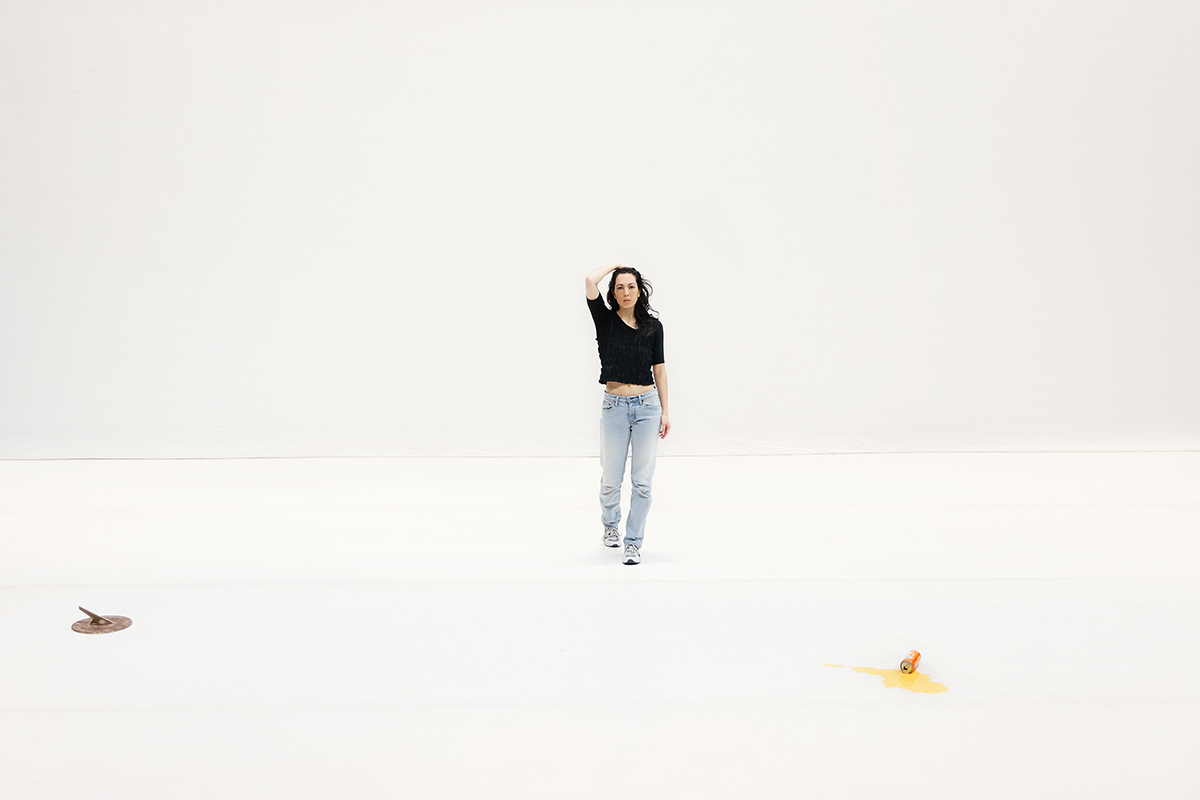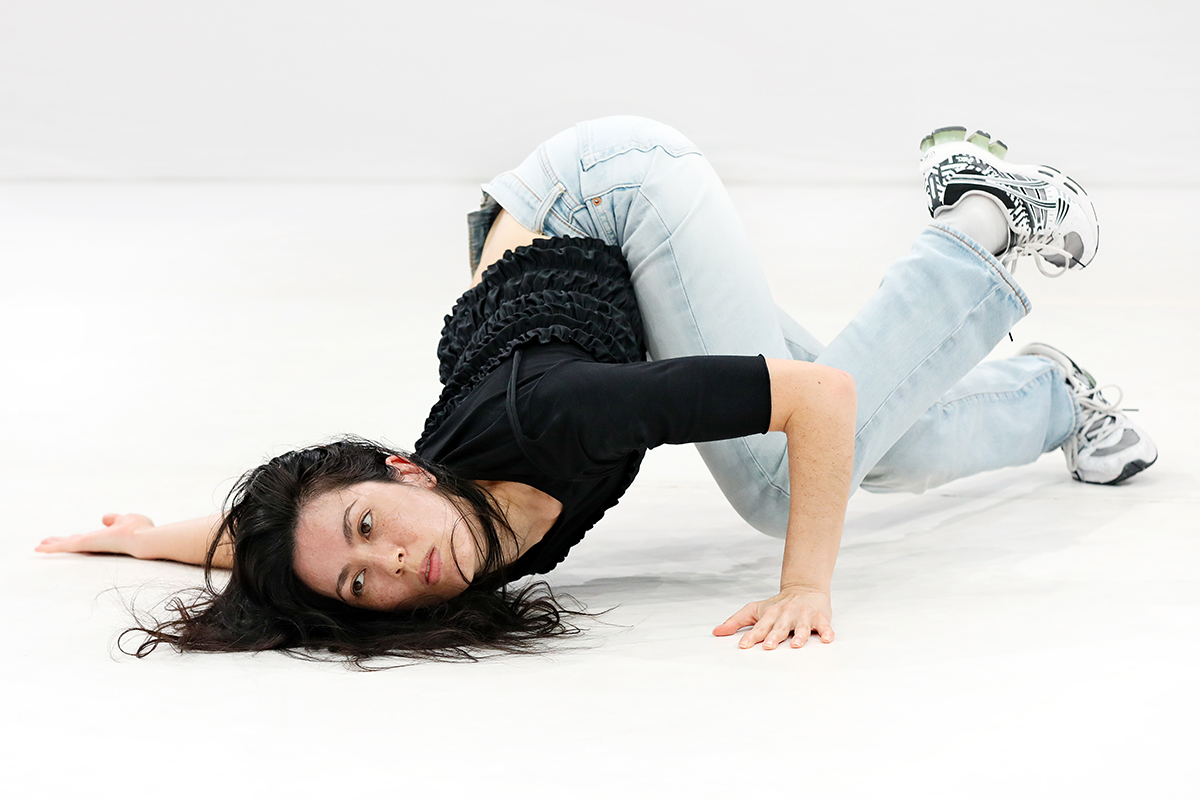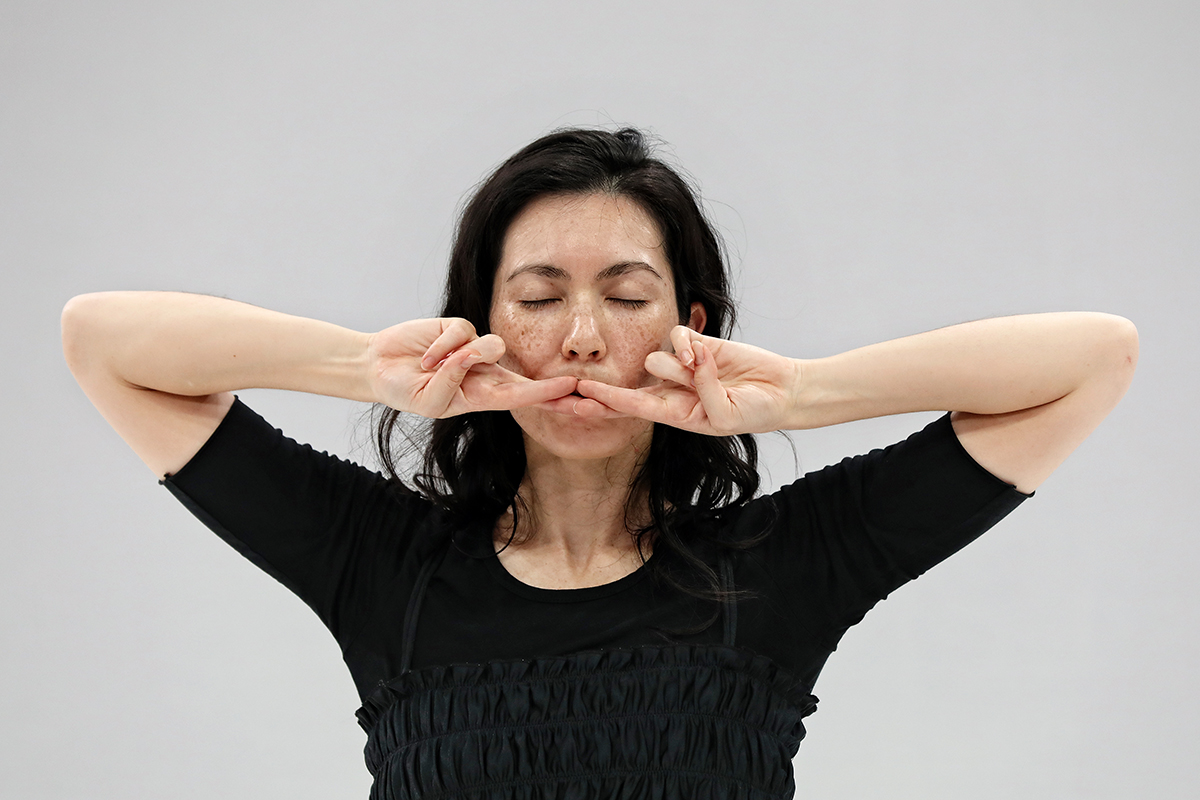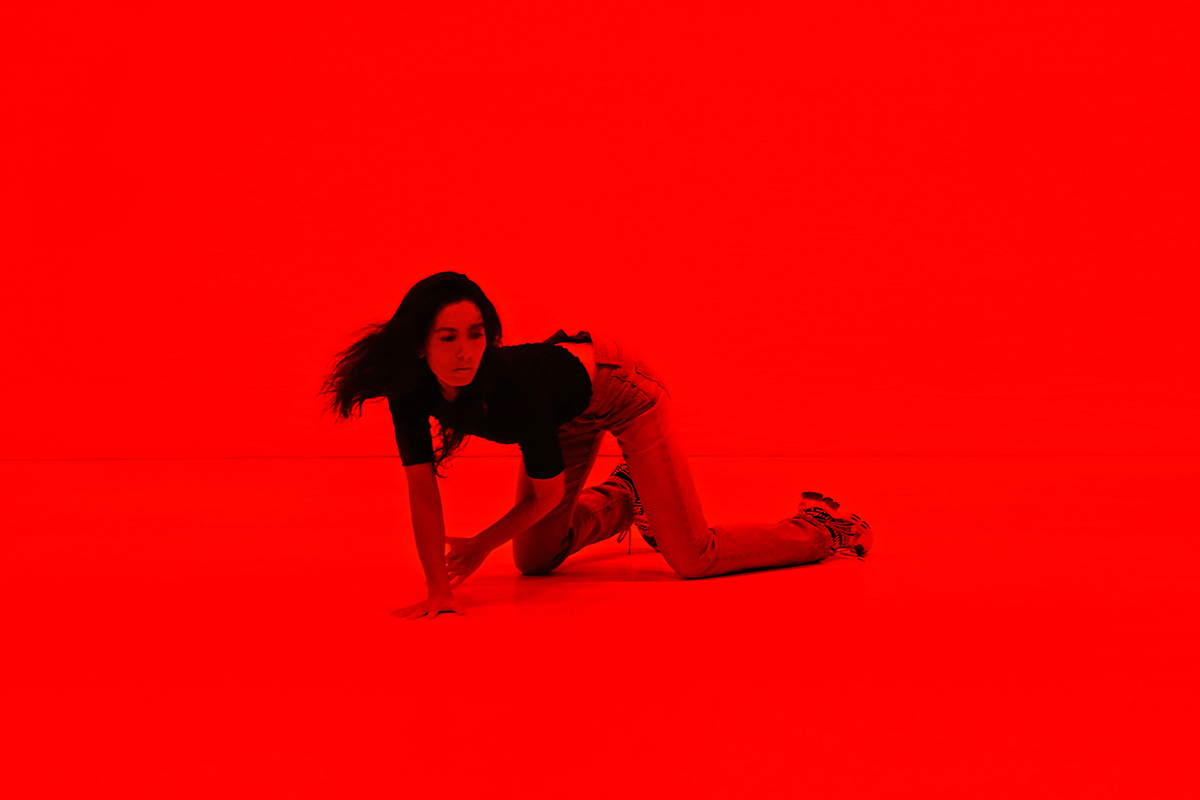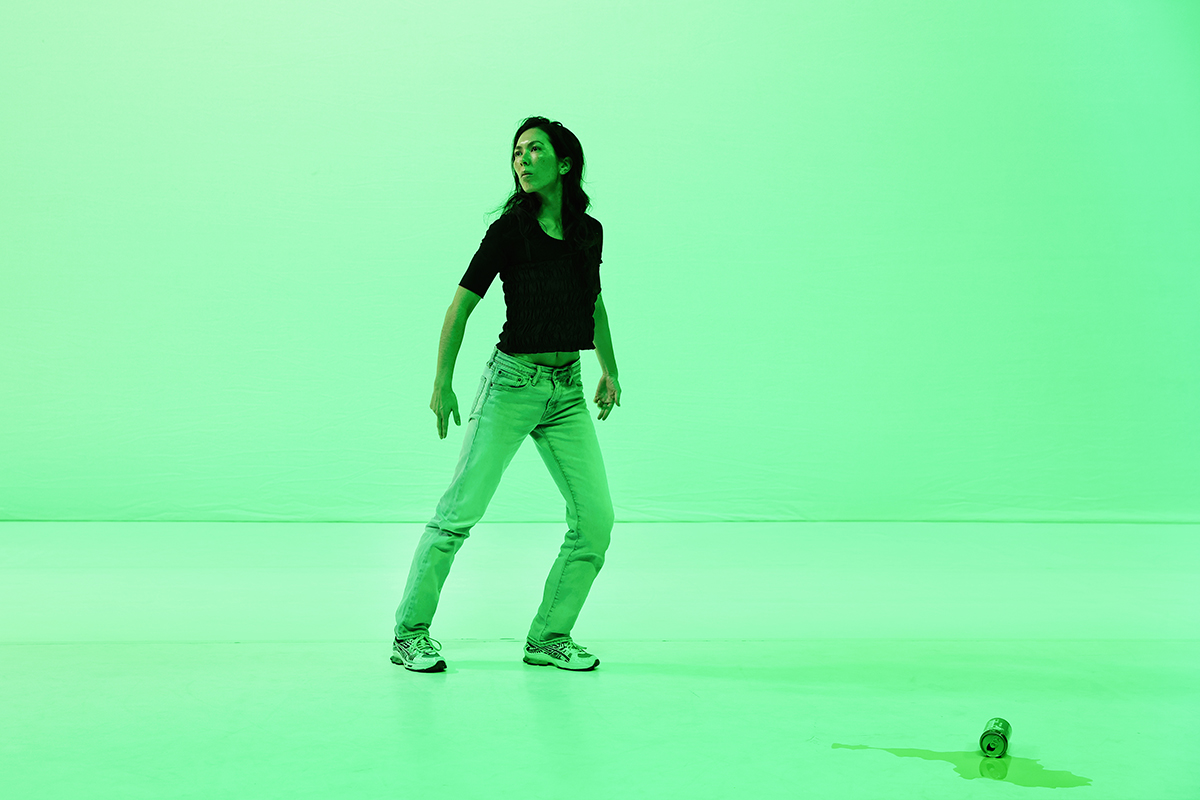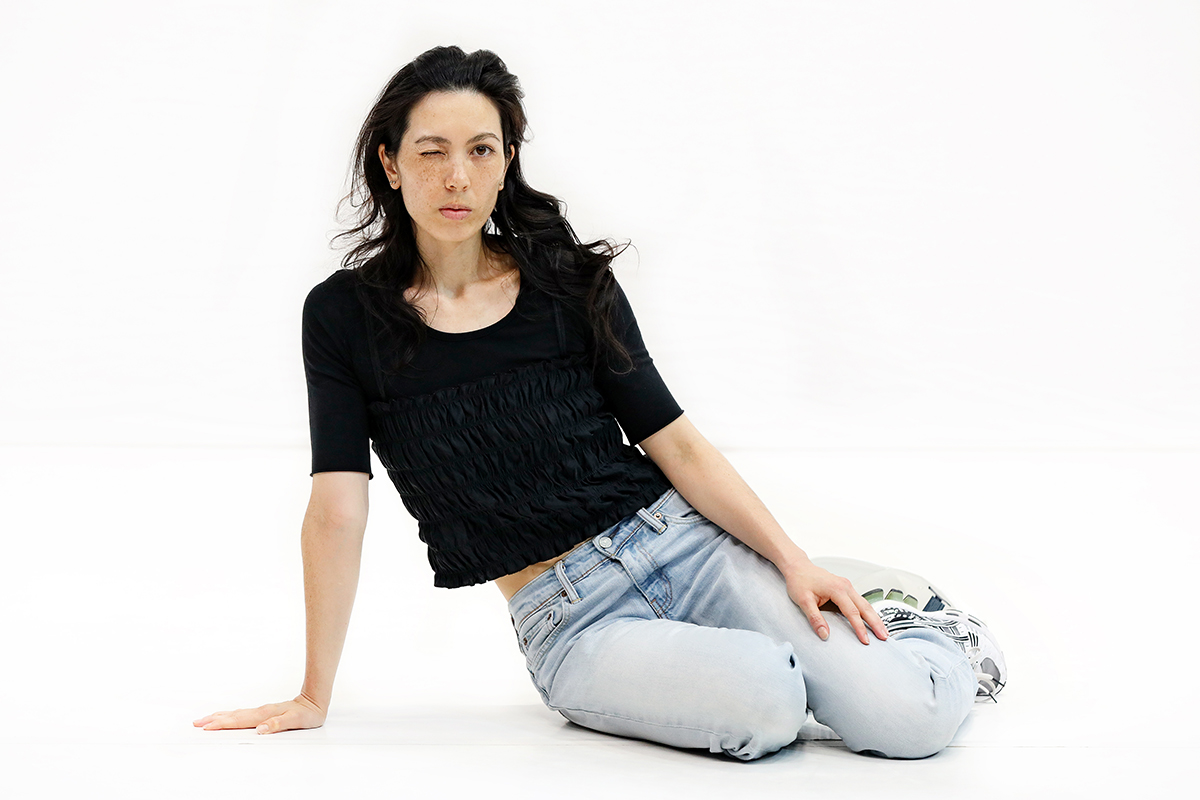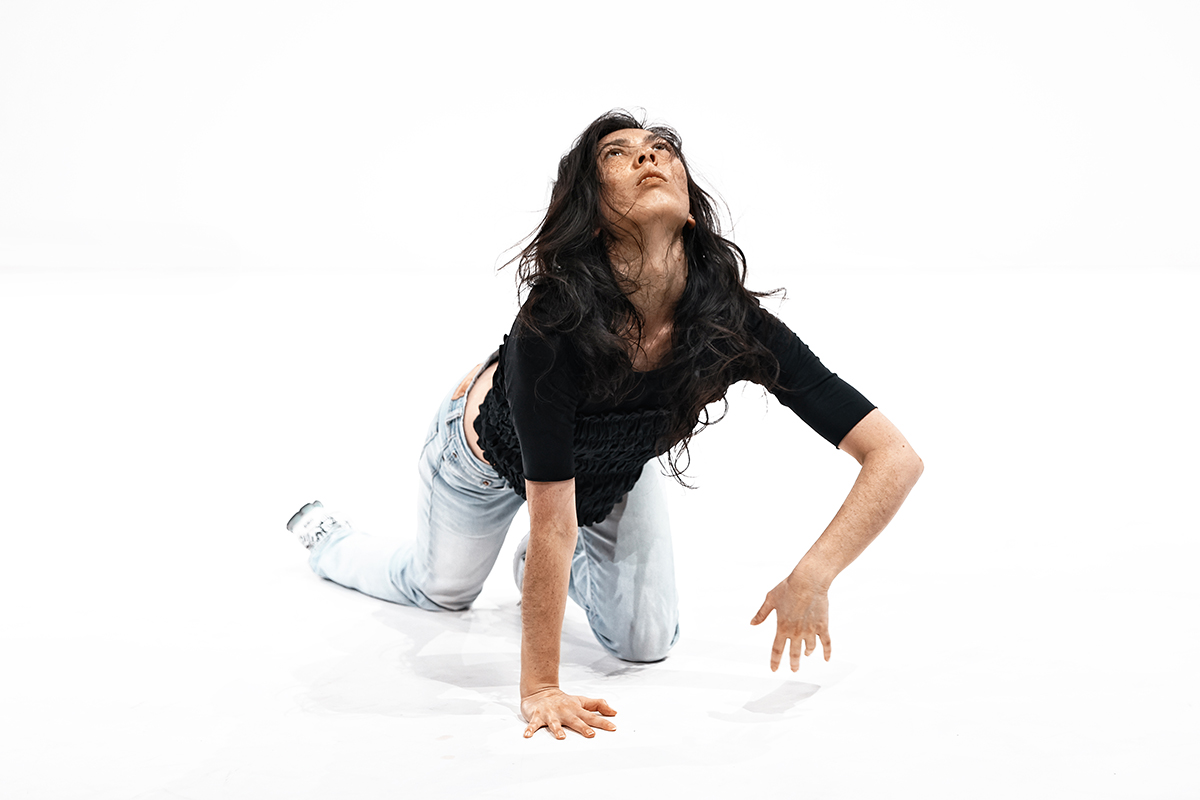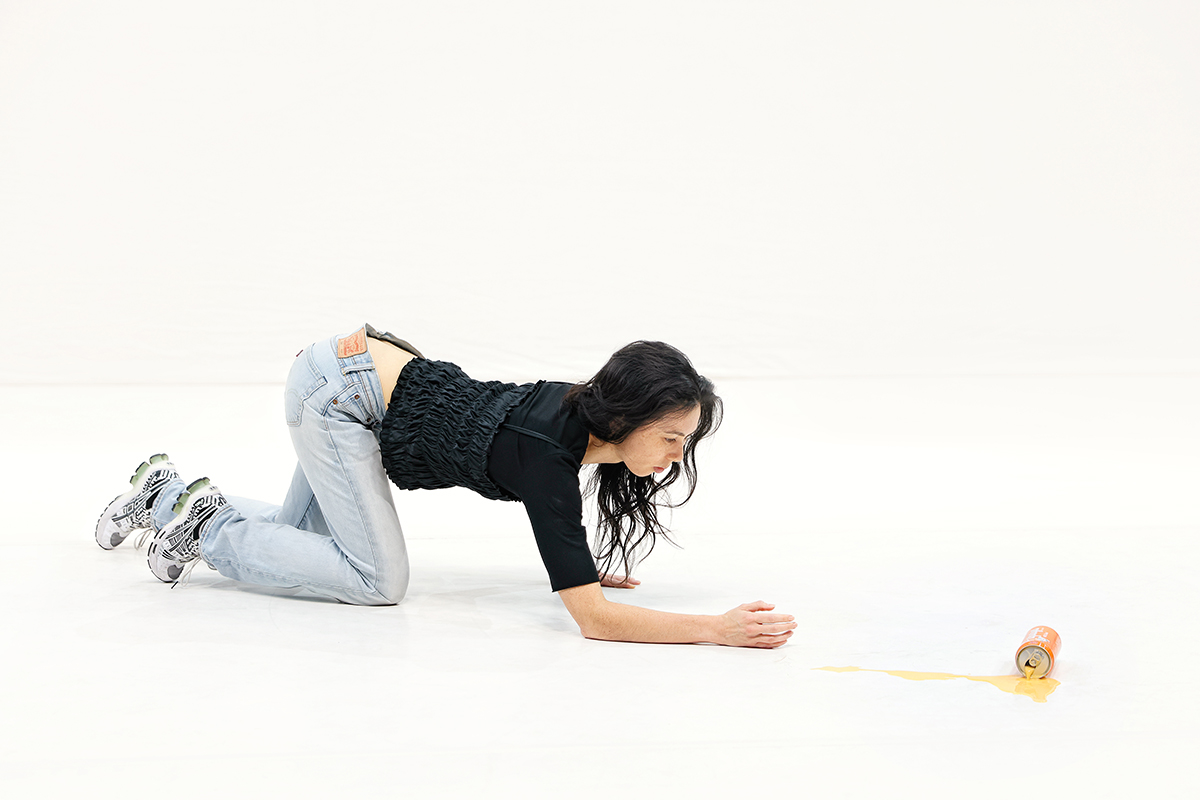
Sky Blue Mythic: Angela Goh’s fantastical myth-making
I’m at The Studio in the Sydney Opera House. It’s the night of the premiere performance of Angela Goh’s Sky Blue Mythic; an expanded version of the 20-minute work that won Goh the 2020 Keir Choreographic Award, which I hadn’t seen. After the show I find a QR code for the program in the foyer. I decide to download but not read the artist statement, not until I’ve written my response.
I don’t want to mess with the disconcerting strangeness that was Sky Blue Mythic by being guided by what Goh thinks she’s made. I’m not altogether invoking the intentional fallacy: “Never trust the teller, trust the tale” (DH Lawrence). I don’t distrust this highly intelligent dancemaker. I am curious to know what she intends, but only after I put my experience into words, and consider what I’m bringing to, and perhaps projecting onto, Sky Blue Mythic. What follows is more essay than review.
Other than working from scribbled notes, recalling how Sky Blue Mythic unfolded was aided by the work’s quite musical construction. Recurrent motifs and their variations are frequently realised as sustained images, often indelibly rendered. But I can’t claim accurate reporting from one viewing. The description that follows might suggest Sky Blue Mythic belted along. Not so. Stillness and movements held in suspension, or obsessively repeated, warped all sense of time. Then there were the shocks: sudden, atypical actions and the sonic boom of Corin Ileto’s music, powerfully underlining the significance, albeit uncertain, of unfolding events.
Seen from memory
A radiant white wall and white floor merge into a stark void. Off-centre left is a small, classic horizontal sundial, the arm angled up to cast its time-telling shadow when placed outdoors. The name of the arm is gnomon – “one that knows or examines,” from the Ancient Greek. A sign that we’re to witness a form of knowing, or an investigation?
In the back left corner, Angela Goh, in a spare black top, pale blue jeans and cap, appears — an everyday presence holding a can of soft drink. A diagonal walk almost two-thirds the way across is broken by an artfully considered fall, almost slow, the can tipping and spilling. We’ve witnessed an ‘accident’ so calculated that it appears to be not the actual event, but rather a re-enactment. A necessary, rehearsed repetition?
Her hands and knees on the floor, Goh’s left arm lifts off, hovers, extends horizontally. With slow momentum the whole body, on three points, turns on an invisible axis, anti-clockwise; a little like a sundial, but reversing time’s passage, and casting no shadow.
Sitting, Goh looks through, at, into us. After a slow blinking, she emphatically closes her right eye and looks with her left. Testing perspective, gauging us? She crawls forward, looking. What are we to do with this looking? Goh’s ever distinctive stare simultaneously establishes and pierces the fourth wall; we inhabit this stark landscape with her — we’re implicated, somehow, but we’re equally outside it.
Contemplating the sundial, she touches the gnomon, initiating a piercing music of metal abrading metal, a chilling circular sawing. She turns the dial anti-clockwise, releasing a primal thumping counterpointed with ascendent female voices. The sound, painfully loud, signals the enormity of this small act and, perhaps in the singing, its pleasure.
The music stops bluntly. Goh exits. Blackout. A stage hand clears the can and cleans the floor. Whatever the plan, has this reversal of time not done its work. Is it too hard?
The void returns, dazzling. Begin again. The walk, fall and spill again. A fraction faster? On all fours again, head raised, Goh cries out in a rounded rising and dipping ‘o’, repeating and repeating, this time partnering her female chorus. To deeply reverberant, forcefully plucked strings, she backs up on all fours, reverses to her starting point. There’s something animal now about this still artfully human body and its cry.
Begin again. She walks slowly to the centre with a pronounced forward tilt, which she holds, making an image of off-centredness, as if something is not right with human erectness. The music snaps aggressively. She looks to her right, sensing what? In a flurry of little steps (a split-second reversal to a classical ballet body?) she backs up, again, to her starting point. The compulsive repetitions and ‘begin-agains’ start to suggest psychodrama on the one hand, or a vigorously formal experiment on the other. Perhaps both.
Centre again, on her back and in one of Sky Blue Mythic’s stranger images, Goh effortlessly flattens to the floor, knees forward, calves folded back tight under thighs. She’s a shape-shifting contortionist, dancer, she’s human and animal, straining to be other, and now other-dimensional.
A series of forms proliferate, oscillating between erect and earthed. She stands, neatly extending and angling her arms in a moment of geometric certitude. Then her right hand pushes her hair back; the hair falls heavily across, erasing her face. Arms again extended she turns anti-clockwise, dextrously on one foot with balletic poise, with a dance body’s certitude. She crawls. She repeats the episodic tilted walk in soft green light. These varied moves are variously bathed in colour washes, red, blue, mauve, suggesting possible states of being, possible choices. Her attention is suddenly caught, white light flares again, her companion female voices silenced. She is propelled backwards. What threatens?
Begin again. She is drawn to and picks up the drink can, memento of the fall. Unfinished business? She holds it, looks to us. Is it any longer recognisable? She puts it down, falls on all fours, repeatedly uttering a worrying new cry, sustained until briefly rising and weakening with a sudden fall. She stops. The stage hand reappears; removes the can. It’s finished with, but not the threat: she looks sharply to her right. Metal grinds metal.
Begin again, with an even stranger development: on her knees, buttocks raised, back sloping to the floor, shoulders down, head weirdly contorted, facing us even as she spins slowly to a high keening and staccato thumping, again moving without apparent volition. A more extreme shape-shifting, organic but seeming even less human.
After being pulled to the right corner into another balletic flurry, she returns centre, the body flattened again, face up, calves under thighs, now pulled anti-clockwise over and over, until my otherwise rapt attention evaporates, the image, already deeply etched, seeming duplicative, no longer evolving.
She stands, falls, rolls, sits, her back to us, and, regaining my attention, to an eerie whistling she gestures upwards; to whom or for what? A hint of supplication? It seems antithetical to the downward push of her shape-shifting, as had the earlier rising female chorus.
On all fours, she moves on the spot, a leopard say, travelling but with forward motion suspended. Her back rounds, head and hair fall down, as she rhythmically flexes with feline ease. It’s a beautiful image, a resolved if temporary transformation.
Begin again. She walks tilting to the centre and slowly turns, a hand raised high. She moves close, demanding we attend to an autonomous dance of hands, fingers coming together in sync with the gentle wave of lyrical metal-edged music. Hands dance high over and behind her head, cross in front of her face, where the fingers lace and then open and close as a single organ. Alien, they probe their way into her mouth. They withdraw, rising to the eyes and pointing upwards.
Music gently chimes from afar. The hands explore whatever this now seated body has become. They lift a leg, feel a thigh, cradle a foot. Goh looks at none of this, only forward. without willing the actions of her body. The music intensifies triumphantly. Fingers independently brush across neck, hair, then back and thighs and neck again as the light softens and withdraws, Goh’s gaze is ever with us, if not felt as quite human, curiously peaceful, if utterly strange, even alien. Darkness.
I say…
I experienced Sky Blue Mythic as a work of fraught progression towards achieving a body devoid of ego consciousness, a project that commenced with a seemingly innocuous (but already rehearsed) fall, a driven task abandoned and obsessively returned to in a host of permutations (the repeated fall, other collapses, the pondered drink can) and the many ‘begin agains,’ in shape-shifting experiments, balletic regressions, the adoption of animal-like forms (and their musical ‘humanimal’ crying), and recurrent tensions between erect, formal aspiration (very human) and a downward thrust into otherness.
Without conscious projection I read Sky Blue Mythic psychologically, as addressing and re-addressing trauma, developing tactics for release, often failing but finally succeeding in some way. The sheer weight and stress of the challenge was felt in the body’s anti-clockwise striving, its reversal of time triggered with the turning of the sundial and felt in the grating power of the musical score. I first thought the reversal regressive, especially in the animal-like transformations (an anthropomorphism eventually abandoned), but the repeated re-wind and starting again grew to feel more like resistance to time’s relentless forward thrust — a stilling of time in order to find another way to be.
The beginnings of Goh’s successful transformation into something a-human were evident in the ease with which the body at its most contorted could rotate without apparent conscious or evident muscular volition, in sharp contrast to those moments when it appeared involuntarily propelled backwards to a starting point. These were stages on the way to the final image of a body examining itself as if for the first time, regardless of its ‘owner.’
I couldn’t easily place those moments when Goh was suddenly alert to actions or sounds off that we couldn’t sense. I think of them now as threats to the project itself, a ‘real’ off-stage world momentarily intruding on a myth-like reverie (myths are full of transformations human to animal or tree or… and, always, an idea), threatening to break the “blue sky thinking” with which Sky Blue Mythic attempts to create a new way of being. While hinting at the meaning of the work, the ungrammatical title is typical of the work’s play with expectation. Sky Blue Mythic is a kind of myth-making, with Goh as the agent herself (no gods here) of potential transformation.
I could only guess at the nature and efficacy of Sky Blue Mythic’s final, seemingly ego-less state of being. Perhaps Goh’s program note would give me an answer. In the meantime, I was left with an acute sense of anxiety and urgency and an abstract sense of resolution. I fixed on the original fall and its permutations. Although ordinary, Goh’s fall momentarily evoked suspended time — falls can be like that: the centre of gravity gone, sheer helplessness (I know, I was recently upended by a bounding labradoodle), until it’s suddenly over. A fall is a crisis, a moment generating fear but also possible insight (into vulnerability, mortality), which is perhaps why Goh’s fall is so considered. What has it told her that drives an intensely physical project that possibly betrays deep anxiety and a woundedness that I’ll come back to?
Angela Goh says…
In her program note, Goh challenges “the arbitrary forms and expressions that structure our worlds” by “work[ing] from the inside, searching for the small opportunities where it might smooth the way for a slip or a glitch that might just open up something unknown from the inside out. Inside out. Upside down. Back to front. Inverted.”
These “arbitrary forms” doubtless range from how we think about and live with our bodies, to dance conventions and to political ideologies that hinder our own and the Earth’s well-being. The “slip or glitch” is realised as the fall that begins the work, freeing the way to an “opening up” of new forms — of dancing, thinking, being.
Goh’s staged fall then is a metaphor for this “slip or glitch,” prompting the sought “opening up.” My sense of a demanding quest full of false starts and seemingly compulsive repetitions suggested something more than a mere ‘slip’ that had to be worked through, underlined by the physical extremity of the movement and the intensity of the design and music. I was, of course, psychologising. But the goal of the quest, to achieve a state other than human, was confirmed by Goh’s note, and that it came from “inside.” Perhaps it’s not a psychological “inside,” but a cognitive or imaginative one, as the use of the word “thinking” suggests as her note goes on.
She writes, “One of the primary drivers for Sky Blue Mythic is to think and approach dance as an extra human sentience rather than a mode of human expression.” She argues that “[t]his requires the body to become an interface rather than a vehicle.” In other words, for the body to be in direct touch with, for example, nature. A larger aspiration follows: “It seems quite pressing to consider the systems that we are part of—ecological, social, technological. We must break from the dangers of human centrism in favour of caring for the tangled relations that make up our more-than-human worlds.”
How can we achieve this? Goh suggests, “Thinking dance as a non-human entity rather than human tool is a fiction that requires a leap into speculation, into imagination.” Some of this imaginative thinking, for example, has become easier with the growing knowledge and appreciation of animal emotion, play, song and culture. Can dance itself achieve this leap? We gratefully witness Goh’s attempt, giving way exactingly, but serenely, to an imagined extra-human selflessness. It’s a fascinating fiction with which to attempt an unmediated relationship with non-human ways of being.
For a non-dancing audience, unable to “de-centre” physically from the impeding weight of Humanism’s anthropocentric legacy, Goh offers some consolation, seeing the mind, not just the body, as an interface: “The mind is also a prehensile organ, grasping worlds that are just out of reach and pulling them closer into being.” As I sat, immersed in Goh’s fantastical vision and the sheer discipline and inventiveness with which she realised it, I was deeply grateful for a fiction with such stated serious intent.
Opposing the West’s relentless progress, Goh argues, “Continuity is our biggest planetary threat. When more of the same is catastrophic, Sky Blue Mythic employs methods of spatial and temporal discontinuity — to glitch, fork, bifurcate, and charter an unhinged journey outwards, from the inside.” Given the work’s almost surreal realisation I find “unhinged” really apt; but for all its quite palpable glitching, forking and bifurcating, the work seemed to me to have an inexorable drive.
The driver is global catastrophe, a fear felt “inside” by many of us every waking day, a woundedness with myriad attendant anxieties and concern for a wounded Earth and flailing social and other systems. It’s not surprising that Sky Blue Mythic exudes a sense of urgency and danger in its quest, via the body, to find a state of mind with which to begin to redemptively undo the damage we humans have done. It’s not surprising to me that I initially took Sky Blue Mythic to be, in some ways, an act of performative self-psychoanalysis, not least since Goh implicates dance, her medium, as part of the problem, for not interfacing with extra-human reality. I have no desire to impose an all-too-human narrative grid over Sky Blue Mythic’s fantastical glitching and looping, to reduce it to a convenient trope, but Goh’s is a human quest after all, leading us towards a sense of what we might be capable of becoming and the healing that might ensue.
After reading Goh’s statement I felt Sky Blue Mythic less perplexing, a sci-fi-like ‘What if…” project, conceptual at root but no less challenging and disconcerting in its attempt to move beyond conveying an idea (dance as vehicle) to rigorously giving body to that idea. And its incredible striving conveyed a deeply felt need, from the inside.
Artists & critics
I couldn’t altogether grasp what Angela Goh had created in performance, art is like that and never less magical for it, but I felt my response was open to her stated vision. Out of performance and reception something else had been created, a “third act.”
In Artforum in February 1985, Jeanne Silverthorne noted “the phenomenologists’ claim that ‘art is . . . not an object but an act.’ Acts are intended. But in the recovery of the artist’s intention, [the critic] both projects parts of [their] consciousness onto the work and makes that consciousness accept the points and barbs of an alien mind set, resulting in a third ‘act’ which opens everything up.” I’ve added a fourth act: my account of Goh’s statement, testing it against my response. Incidentally, “alien mind set” seems an amusingly apt descriptor for a work in which Goh becomes so other in the end.
Audiences and critics determine for themselves what a work means, regardless of the maker’s intention. In her five-star review for Limelight, Deborah Jones resolutely set aside Goh’s program note, writing, “To this audience member Goh is exploring precisely the boundaries of what the body can do and what it means to be human in an alien environment. The body and the humanity are one.” To which one might sadly add, “…and alone” if it means the disconnect between ourselves and nature is to persist.
Artists need to be listened to; innovators are often ahead of us and their words can prod us towards understanding the new experiences they conjure. But how seriously should artists take critics?
Silverthorne writes: “The critic’s abstinence from premature information provided by the artist has an analogue in the artist’s wariness of criticism. If the artist listens too religiously, he or she has no chance to work through a development, and whatever changes are made will never be profound. In a sense, artists have to ignore criticism, because they cannot arm themselves against hearing it and the useful remarks will make themselves felt only when the artist is ready for them. Criticism is not, in general, a way of making art behave. It is, however, crucial to art’s intellectual life.”
With reference to…
It’s fun (and meaningful) to dig into the first paragraph of Angela Goh’s artist statement which rattles off artworks, films and ideas that influenced the making of her creation, “all of which become arbitrary once Sky Blue Mythic begins to become a world of its own, and more than just its inspirations.”
Alongside popular culture references, there’s a noticeable preoccupation with time, not least in science and science fictions. These include Edward A Abbott’s Flatland: A Romance of Many Dimensions, a 19th century mathematical and social satire (one anticipating the theory of time as the fourth dimension) that depicts a two-dimensional world in which men are polygons and women line segments, paralleling Goh’s transformation into a ‘flattened’ form. There’s Giselle, who collapses and dies and defies time by returning as a ghost, and Walter Benjamin’s Angel of History, blown into the future by progress but facing the wreckage (imagine climate change, mass inequality etc) behind.
Also listed are the concept of Time’s Arrow and the novel Hard to be a God by the Russian science fiction writers Arkady and Boris Strugatsky Brothers’ (or is it Aleksei German’s film of the book?) about a culture in temporal lockdown. Xenofeminism, which embraces de-gendered science and technology, gets a mention. So does Thomas Moynihan’s spinal catastrophism (too difficult to explain here, but one of its key starting points is the ‘accident’ of human upright posture as “evolutionary trauma” in our relationship with nature) which might explain some of Goh’s tilted bi-pedal choreography. And there’s more. These references can’t define Sky Blue Mythic, but Goh makes the offer, implicitly encouraging us to consider them and, if there’s the opportunity to revisit the work, enjoy a richer reflection on the experience.
On reflection
I was open to Sky Blue Mythic’s visceral power and its sense of quest. After all, this was a rare visit to the theatre in COVID-time, I’d been ill and the Moon was red, so it’s not surprising I read the work as self-psychoanalytic, a projection encouraged by the work’s insistent glitching and looping. In Goh’s vision these are not metaphors for a psychological condition but for tech means with which to facilitate her avatar’s quest — with Goh doing a William Gibson, generating a performative zone equivalent to cyberspace on stage (also felt, if differently, in Goh’s allusion rich Uncanny Valley Girl with the performer as borderline cyborg).
Goh’s impressive repertoire includes Desert: Body Creep (2016) and Uncanny Valley Girl (2018), solo performances fusing performance art, movement and installation, and the fascinating Scum Ballet (2017), an emphatically danced ensemble work rich with moments of haunting stillness, threat and care. Compared with those solos, Sky Blue Mythic feels more palpably organic, its references deeply embedded, its sense of purpose more potent. It might not have yielded the dancing that some desire, but every movement is considered and can only come from a highly disciplined dancer with a creative imagination that can render the human body strange and newly oriented. I was gripped by Sky Blue Mythic, a work both coherent and continually surprising, its choreography, music and design coalescing to generate a provocative, utterly memorable otherworld I hope to enter again and, in the world outside, with my imagination, and senses, embrace the extra-human.
—
UnWrapped: Sky Blue Mythic, choreographer, dancer Angela Goh, lighting designer Ruben Govin, composer Corin Ileto, production manager Matt Cornell; The Studio Theatre, Sydney Opera House, 26-29 May, 2021. Winner of the 2020 Keir Choreographic Award, the full-length Sky Blue Mythic was commissioned by Sydney Opera House’s New Work Now initiative.
Reviews of other works by Angela Goh:
Desert: Body Creep (2016), “Next Wave Festival: Dance, decay & transformation” and “Next Wave Festival: Shaking loose the self”
Scum Ballet (2017): “Angela Goh, Scum Ballet: Female magic”
Uncanny Valley Girl (2018): reviewed in Running Dog and Art and Australia
Top image credit: Angela Goh, Sky Blue Mythic, photo Prudence Upton


